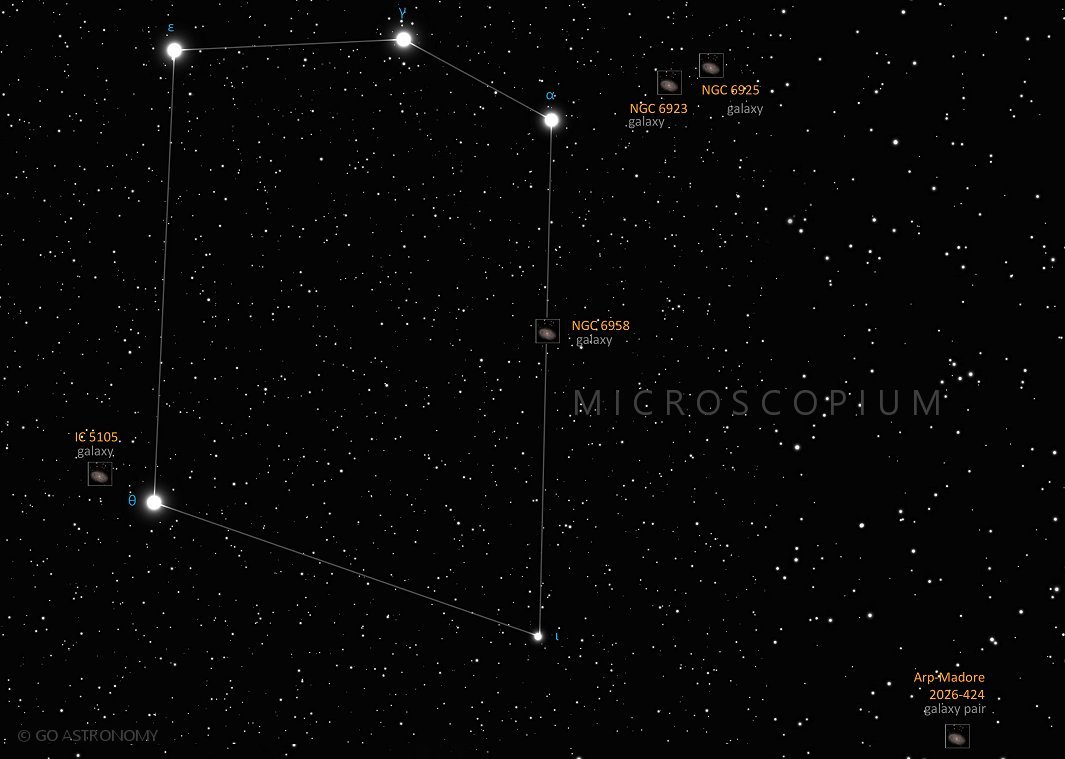Microscopium, the Microscope (Mic)
(my-cruh-SCOPE-ee-um)
The Southern constellation of Microscopium, the Microscope, is best viewed in Fall during the month of September.
Microscopium is the 66th largest constellation. It's brightest star is Gamma Microscopii at magnitude 4.67. The boundary of the Microscopium constellation contains 7 stars that host known exoplanets.
- Pronunciation:
- my-cruh-SCOPE-ee-um
- Meaning:
- Microscope
- Genitive:
- Microscopii
- Abbreviation:
- Mic
- Constellation Family:
- LaCaille
- Hemisphere:
- Southern
- Quadrant:
- SQ4
- Visibility:
- 45° N - 90° S
- Best viewing month*:
- September
- Area:
- 210 sq. degrees
- Size:
- 66th largest
- Right Ascension (avg):
- 20h 57m
- Declination (avg):
- -36°
- Brightest star:
- Gamma Microscopii (4.67)
- Stars with planets:
- 7
- Messier objects:
- |
- Caldwell objects:
- |
Brightest Stars in Microscopium
The 10 brightest stars in the constellation Microscopium by magnitude.
- Star
- Magnitude
- Spectral class
- Gamma Microscopii (γ Mic)
- 4.67
- G8III
- Epsilon Microscopii (ε Mic)
- 4.71
- A0V
- Theta Microscopii (θ1 Mic)
- 4.8
- A2p
- Alpha Microscopii (α Mic)
- 4.89
- G8III
- Iota Microscopii (ι Mic)
- 5.11
- F1IV
- Nu Microscopii (ν Mic)
- 5.12
- K0III
- 2 Microscopii (2 PsA)
- 5.2
- K2III
- HD 201772
- 5.25
- F5V
- Zeta Microscopii (ζ Mic)
- 5.32
- F3V
- HD 198716
- 5.34
- K2III
Galaxies in Microscopium
The most notable galaxies in the constellation Microscopium. Also see all galaxies.
The Celestial Microscope
Microscopium, the Microscope, is a small, faint constellation in the Southern Hemisphere, introduced in the 18th century by French astronomer Nicolas Louis de Lacaille. Its name comes from the Latin "Microscopium," which means microscope, reflecting Lacaille's dedication to commemorate technological and scientific advancements of his time in the skies.
Historical Overview
The constellation Microscopium was created by Lacaille during his expedition to the Cape of Good Hope in South Africa from 1751 to 1753. Here, he observed and catalogued nearly 10,000 southern stars. Lacaille created and named 14 constellations during his stay, all named after scientific and artistic instruments. Microscopium is one of these 'Lacaille constellations,' named after the microscope to honor the contributions of this instrument to science.
Location and Main Features
Microscopium is located in the fourth quadrant of the southern hemisphere (SQ4), and can be seen at latitudes between +45? and -90?. It lies between the constellations of Capricornus and Sagittarius to the north, Grus to the south, and Piscis Austrinus and Indus to the east and west, respectively. Despite its rather unassuming stars, Microscopium covers an area of 210 square degrees, ranking it 66th in size among the 88 constellations.
Main Stars in Microscopium
The brightest star in Microscopium, Gamma Microscopii, shines with an apparent magnitude of 4.68, making it just visible to the naked eye under good viewing conditions. This star is an orange giant located about 229 light years from the solar system.
The second brightest star, Epsilon Microscopii, is a white giant located approximately 182 light years away from us, shining with an apparent magnitude of 4.72. Theta1 Microscopii, the third brightest star, is actually a binary star system, consisting of a white dwarf and an orange giant star.
Deep Sky Objects
While there are no Messier objects within the boundaries of this constellation, it does host a few galaxies. These include the spiral galaxy NGC 6925 and a pair of galaxies, NGC 6923 and NGC 6928, which can be observed with a mid-sized telescope.
Observation
Observing Microscopium can be challenging due to its relatively faint stars. The constellation reaches its highest point in the evening sky in late August. For observers located in the northern hemisphere, the constellation remains low on the horizon and is best seen during summer months. In the southern hemisphere, Microscopium is more readily visible, appearing higher in the sky.
While it may not have the fame of some other constellations, Microscopium carries a unique place in the celestial sphere. It is a reminder of the age of Enlightenment when it was created, a time when the microscope and other scientific instruments were beginning to reveal the hidden intricacies of the world around us. Thus, while it may be faint, Microscopium serves as a beacon of scientific progress and discovery in the night sky.
* Constellation shown for northen hemisphere skies. For the southern hemisphere, constellations appear rotated 180 degrees (upside-down and left-right reversed) from what is shown. Remember that seasons are reversed too - summer in northern latitudes is winter in southern latitudes.
** Circumpolar constellations are visible year-round in the hemisphere listed (and not at all in the opposite hemisphere).





